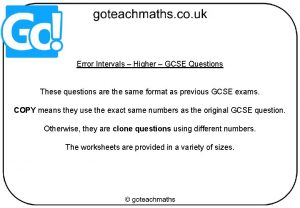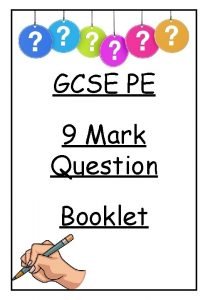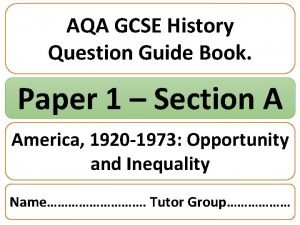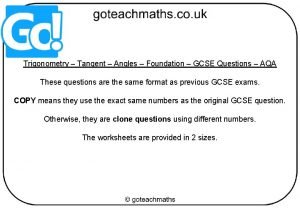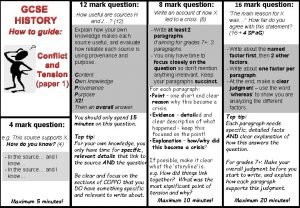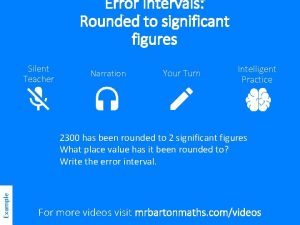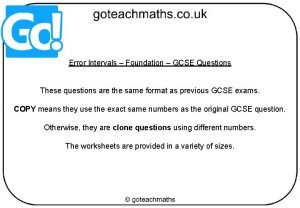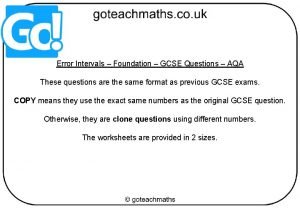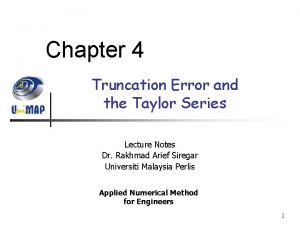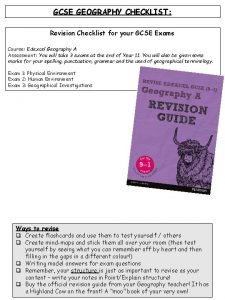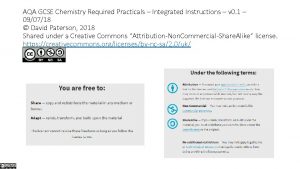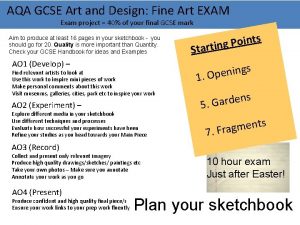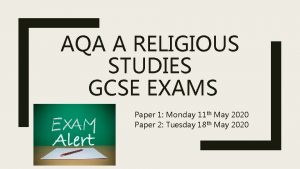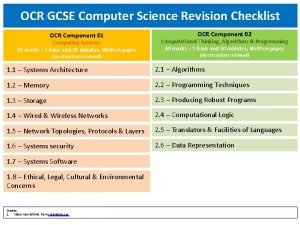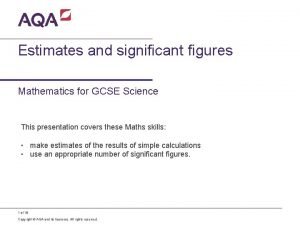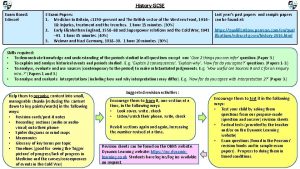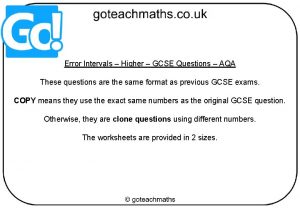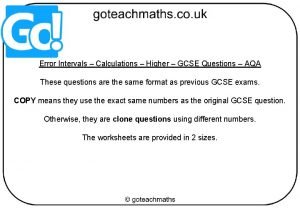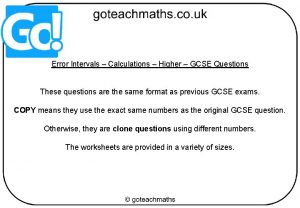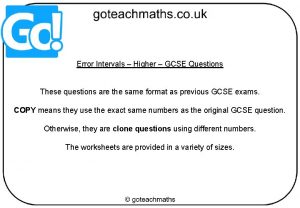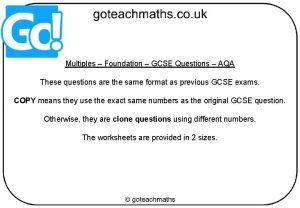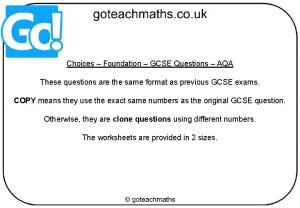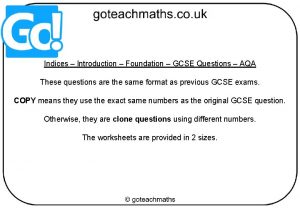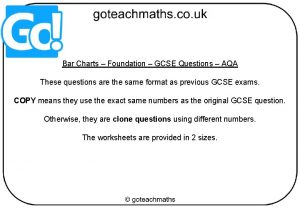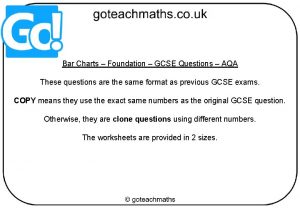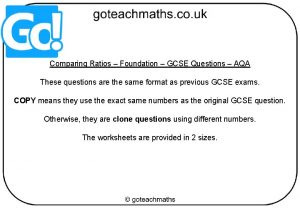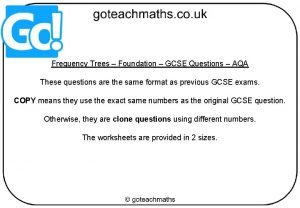Error Intervals Foundation GCSE Questions AQA These questions















- Slides: 15

Error Intervals – Foundation – GCSE Questions – AQA These questions are the same format as previous GCSE exams. COPY means they use the exact same numbers as the original GCSE question. Otherwise, they are clone questions using different numbers. The worksheets are provided in 2 sizes.

Printing To print handouts from slides Select the slide from the left. Then click: File > Print > ‘Print Current Slide’ To print multiple slides Click on a section title to highlight all those slides, or press ‘Ctrl’ at the same time as selecting slides to highlight more than one. Then click: File > Print > ‘Print Selection’ To print double-sided handouts Highlight both slides before using ‘Print Selection’. Choose ‘Print on Both Sides’ and ‘Flip on Short Edge’.

AQA Foundation: June 2017 Paper 3, Q 23 1 (a) The length of some fabric is 8 metres to the nearest metre. Complete the error interval for the length of the fabric. Answer m �length < AQA Foundation: June 2017 Paper 3, Q 23 [1 mark] m 1 (b) The length of a different piece of fabric is 7 metres to the nearest metre. Jenny says, “The total length of the two pieces of fabric is 14 metres to the nearest metre. ” Give an example to show that she could be correct. [2 marks] 1 (a) The length of some fabric is 8 metres to the nearest metre. Complete the error interval for the length of the fabric. Answer m �length < m 1 (b) The length of a different piece of fabric is 7 metres to the nearest metre. Jenny says, “The total length of the two pieces of fabric is 14 metres to the nearest metre. ” Give an example to show that she could be correct. [2 marks] AQA Foundation: June 2017 Paper 3, Q 23 1 (a) The length of some fabric is 8 metres to the nearest metre. Complete the error interval for the length of the fabric. m �length < [1 mark] AQA Foundation: June 2017 Paper 3, Q 23 [1 mark] m 1 (b) The length of a different piece of fabric is 7 metres to the nearest metre. Jenny says, “The total length of the two pieces of fabric is 14 metres to the nearest metre. ” Give an example to show that she could be correct. [2 marks] 1 (a) The length of some fabric is 8 metres to the nearest metre. Complete the error interval for the length of the fabric. Answer m �length < [1 mark] m 1 (b) The length of a different piece of fabric is 7 metres to the nearest metre. Jenny says, “The total length of the two pieces of fabric is 14 metres to the nearest metre. ” Give an example to show that she could be correct. [2 marks]


AQA Foundation: June 2018 Paper 2, Q 28 1 AQA Foundation: June 2018 Paper 2, Q 28 The length of each side of a regular hexagon is 7. 3 cm to 1 decimal place. 1 1 (a) Complete the error interval for the length of one side. The length of each side of a regular hexagon is 7. 3 cm to 1 decimal place. 1 (a) Complete the error interval for the length of one side. [2 marks] cm �length < [2 marks] cm cm �length < 1 (b) Complete the error interval for the perimeter. cm 1 (b) Complete the error interval for the perimeter. [1 mark] cm �perimeter < [1 mark] cm cm �perimeter < AQA Foundation: June 2018 Paper 2, Q 28 1 cm AQA Foundation: June 2018 Paper 2, Q 28 1 The length of each side of a regular hexagon is 7. 3 cm to 1 decimal place. 1 (a) Complete the error interval for the length of one side. [2 marks] cm �length < cm [2 marks] cm �length < 1 (b) Complete the error interval for the perimeter. cm 1 (b) Complete the error interval for the perimeter. [1 mark] cm �perimeter < cm


AQA Foundation: November 2017 Paper 1, Q 24 1 Three whole numbers are each rounded to the nearest 10 The sum of the rounded numbers is 50 AQA Foundation: November 2017 Paper 1, Q 24 1 Work out the maximum possible sum for the original three numbers. Three whole numbers are each rounded to the nearest 10 The sum of the rounded numbers is 50 Work out the maximum possible sum for the original three numbers. [2 marks] Answer








Questions? Comments? Suggestions? …or have you found a mistake!? Any feedback would be appreciated . Please feel free to email: tom@goteachmaths. co. uk
 What is an error interval
What is an error interval Gcse pe 9 mark question examples
Gcse pe 9 mark question examples Aqa history paper 1
Aqa history paper 1 Gcse angles questions
Gcse angles questions How to answer a 12 mark question in history
How to answer a 12 mark question in history How to do error intervals
How to do error intervals Error intervals
Error intervals Error intervals
Error intervals How to find truncation error in taylor series
How to find truncation error in taylor series Gcse geography edexcel b revision checklist
Gcse geography edexcel b revision checklist Aqa chemistry gcse required practicals
Aqa chemistry gcse required practicals Aqa art and design a level
Aqa art and design a level Aqa rs gcse past papers
Aqa rs gcse past papers Ocr computer science checklist
Ocr computer science checklist Significant figures gcse
Significant figures gcse Re gcse past papers edexcel
Re gcse past papers edexcel
